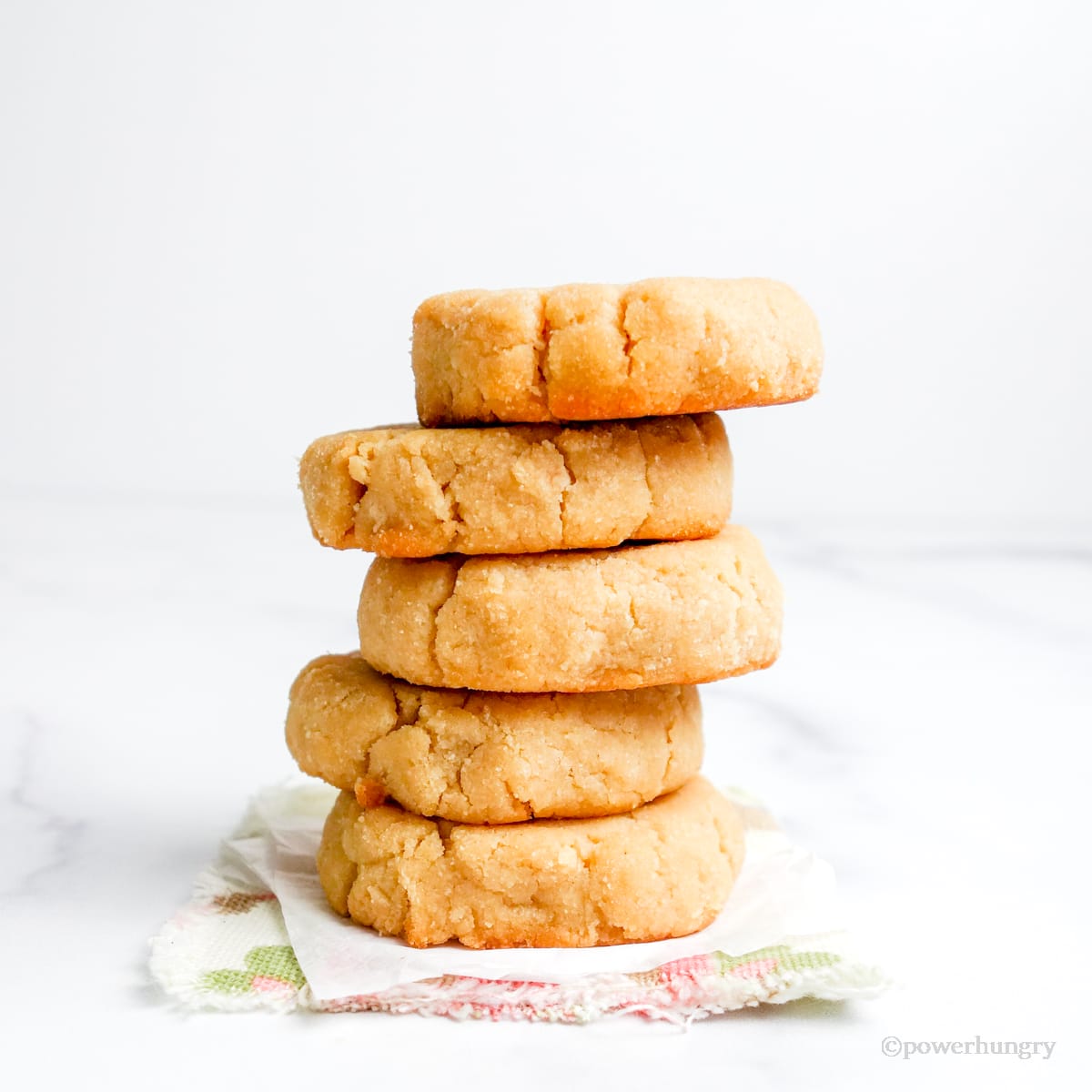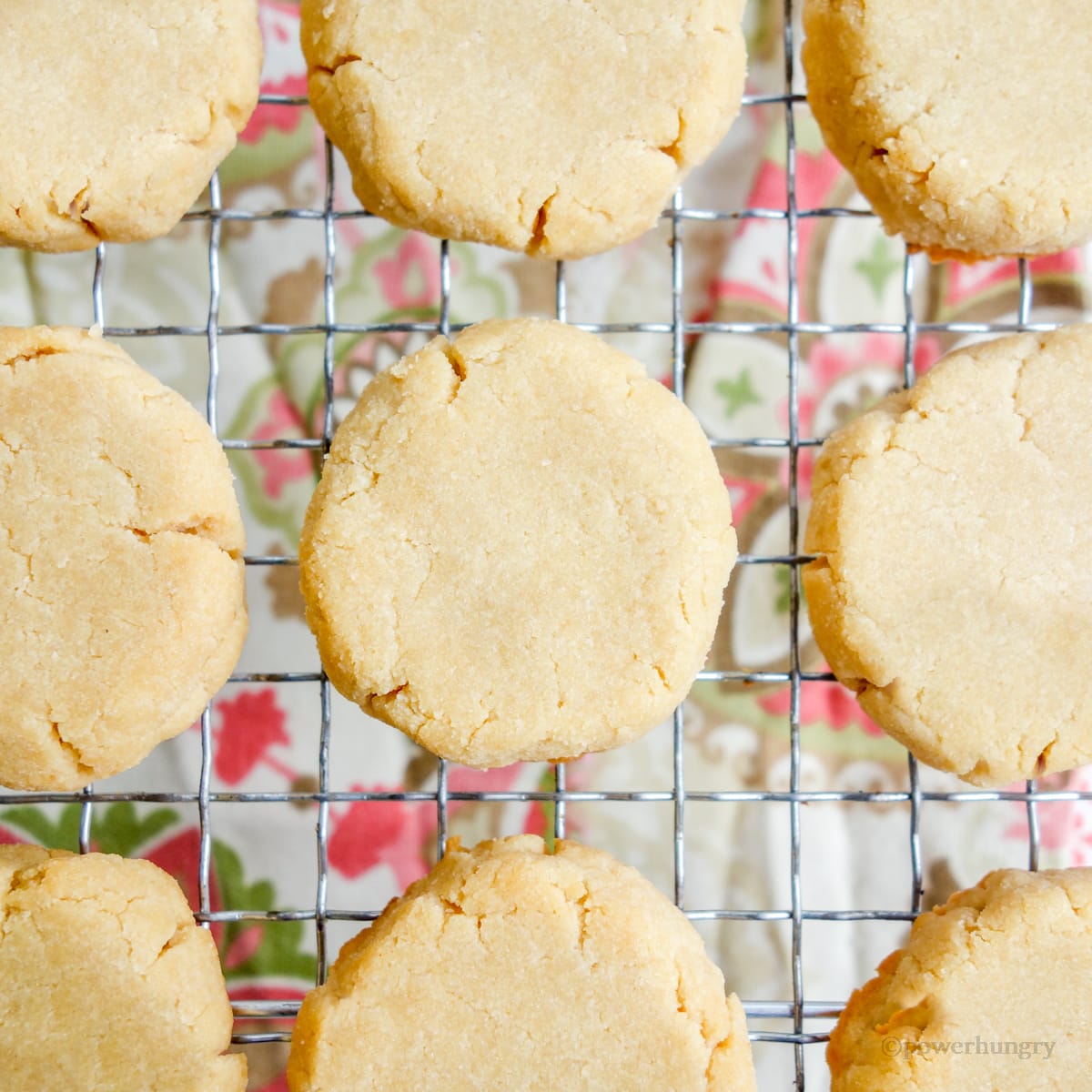My 3-ingredient coconut flour shortbread cookies are fast, easy, frugal, and so delicious! Vegan and grain-free, these cookies have all of the hallmarks of superior shortbread. They ae also keto-friendly (with 1 ingredient swap).
Quick & Easy Coconut Flour Shortbread
Shortbread cookies are loved by one and all for their classic flavor, delicate texture, and endless versatility. Now you can make shortbread made with coconut flour--a naturally grain-free, gluten-free, low carb, and faintly sweet flour--in a matter of minutes and no fuss.
Once you learn the basic recipe, the same cookie can be made many times over with different flavors--spices, citrus zests, and extracts--to make countless delicious and exciting combinations.
 Vegan Coconut Flour Shortbread Features
Vegan Coconut Flour Shortbread Features
Here's what you need to know about these irresistible cookies. They are:
- Made with 3 ingredients (coconut flour, coconut oil & sweetener)
- Very quick & easy to make (no chilling before baking)
- Vegan (egg-free & dairy-free)
- Gluten-free
- Grain-free
- Nut-free
- Paleo
- Keto (with 1 ingredient swap)
What is the Texture of the Cookies?
Once chilled, the cookies have a traditional shortbread cookie texture: melt-in-your mouth tender. They are not too hard, not too soft, and 100% just right.
What Makes these Shortbread Work
Coconut flour can be tricky when it comes to developing recipes. But it can also produce some incredible baked goods once the method is right.
- The correct ratio of fat to coconut flour. The first key to getting the right texture for coconut flour shortbread cookies is using the right ratio of fat to flour: too little coconut oil will lead to choke-worthy shortbread. Add too much and the cookies will fall apart.
- The addition of water. These shortbread require something that traditional shortbread cookies do not: water. Coconut flour is extremely absorbent and needs some extra moisture, even for a shortbread-style cookie like this.
- Accurate measurement. It is best to weigh coconut flour rather than measure with cups. I go into more specifics below.
Ingredients for the Shortbread Cookies
Here are the three ingredients needed to make these super-cookies:
- Coconut flour
- Coconut sugar (I have options, including keto-friendly granulated sweetener)
- Coconut oil
You will also need 1/4 cup warm water.
I recommend adding 1/8 teaspoon of salt, too, but it is optional according to your tastes and dietary needs.
Recipe Accuracy: Weigh Your Ingredients
This is such a simple recipe, but it can go wrong if the measurements are not accurate.
This is especially true for the coconut flour. It is very easy to measure too much coconut flour if using measuring cups. Coconut flour is very light and is used in smaller amounts than grain flours. Just a little bit too much can make the cookie dough and the cookies dry and crumbly.
A digital kitchen scale is inexpensive. It is worth every penny! If you do a little or lot of unconventional baking (e.g., vegan, gluten-free, grain-free), a digital kitchen scale will make your baking easier and prevent disasters from occurring. Ok, I'll get off of my soap box now and return to the recipe :).
How to Make the Dough for 3-Ingredient Coconut Flour Shortbread
The dough for these shortbread cookies is very quick and easy to prepare.
Before you begin, be sure to do the following:
- Prepare a baking sheet by lining it with parchment paper (you will need to be ready to scoop the dough as soon as it is mixed).
- Melt the coconut oil just before mixing the dough (so that it is still very warm).
Whisk the coconut flour, sweetener, and optional salt in a medium bowl, breaking up any and all lumps.
Add the VERY WARM coconut oil and warm water, stirring until completely combined. The dough is unlike should be moist and sand.
Scoop and Shape the Dough
Working quickly, scoop the dough into 10 equal mounds onto the prepared baking sheet (leave about 2 inches/5 cm distance between the mounds). I used my small cookie scoop to create rounded mounds. A tablespoon measure, just full and leveled off, will also work.
Use your fingertips to pat the dough mound, smoothing the edges.
Why is it Necessary to Work Quickly?
As the water and coconut oil cool, the dough changes from n easily scoopable dough to crumbs (difficult to scoop and shape). It is also why it is important to use very warm coconut oil and very warm water when mixing the dough (more time to work with a warm dough).
Once the cookies are scooped and shaped, the rush is over (e.g., if you forgot to preheat the oven, it is fine for the cookies to sit and re-harden before baking).
If the dough crumbles from the coconut oil solidifying (distractions and interruptions can happen!), try popping the dough into the microwave for 5 to 10 seconds to rewarm it.
Bake the Cookies
Bake the cookies in a preheated 325F oven for 20 to 23 minutes until set and light golden brown at the edges. The cookies will still look moist and underdone due to the high percentage of coconut oil to flour.
Leave the cookies on the baking sheet for 10 minutes before transferring to a cooling rack to cool completely. They are fragile when they first emerge from the oven.
Shortbread. Delectable shortbread. Ready to be nibbled or devoured, per your preferences.
The cookies are delicate while still warm. They are less so once completely cooled, and firm as shortbread once chilled (I recommend storing them in the refrigerator).
Variations: Add Spices, Extracts or Citrus Zest
If you like, you can also add in spices, citrus zest, or a small amount of vanilla extract (or other extracts) to enhance or vary the flavor. This is your template cookie for all kinds of variations!
Chocolate: Always a Variation!
The cookies do not work as chocolate chip cookies (the warm dough will melt any added chocolate chips).
But you can always add chocolate afterwards by dipping or drizzling the cookies. Yes, please.
FAQ
Q: Can I use a different flour in place of the coconut flour?
A: No, this recipe will only work with coconut flour. Other grain-free flours, such as almond, cassava, or chickpea flour, will not work in the same proportions.
Q: My cookie dough turned out dry and crumbly. Why?
A: It is almost certainly due to adding too much coconut flour, and possibly too much flaxseed meal. This can happen from measuring using cup measures instead of weight measures. For best results, weigh the ingredients (the coconut oil and sugar, too). If using cups, very lightly spoon in the dry ingredients and level with a knife.
Q: Can I substitute another oil for the coconut oil?
A: No, other oils will not work in this recipe. It demands a fat that is solid at cool room temperature or when chilled. Plant butter (vegan margarine) that is sold in sticks (e.g., Earth Balance buttery sticks, Flora plant butter, or Country Crock plant butter) can be used in place of the coconut oil. It is important to use a plant butter with a high fat content (some margarines, even sticks, have a high percentage of water). If you are not vegan, an equal amount of butter can also be used.
Happy baking!
Related Posts:
- 3-Ingredient Almond Flour Cookies {Vegan, Oil-Free, Keto Option}
- Chocolate Coconut Flour Cookies {Vegan, Keto Option}
- Keto Vegan Coconut Flour Cookies {grain-free, gluten-free}
- Healthy Chocolate Banana Oat Cookies {vegan, oil-free, GF}
- Oat Banana Coconut Oil Energy Cookies {vegan, GF}
- 3-Ingredient Flax Shortbread Cookies {vegan, GF, keto option}
[tasty-recipe id="23411"]










0 comments